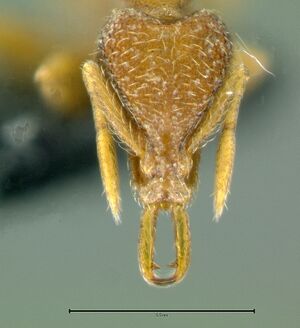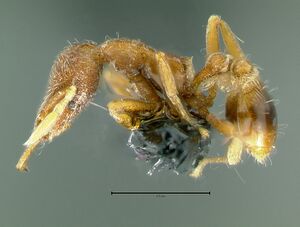Strumigenys tenitecta
| Strumigenys tenitecta | |
|---|---|

| |
| Scientific classification | |
| Kingdom: | Animalia |
| Phylum: | Arthropoda |
| Class: | Insecta |
| Order: | Hymenoptera |
| Family: | Formicidae |
| Subfamily: | Myrmicinae |
| Tribe: | Attini |
| Genus: | Strumigenys |
| Species: | S. tenitecta |
| Binomial name | |
| Strumigenys tenitecta Bolton, 2000 | |
Known from a holotype worker, collected in a rainforest litter-sample.
Identification
Bolton (2000) - A member of the smythiesii complex in the Strumigenys godeffroyi-group. See notes under Strumigenys lichiaensis. This minute species is superficially similar to the common and widely distributed Strumigenys rofocala. The latter lacks flagellate hairs on the hind basitarsus and has the base of the apical antennal segment attenuated and narrowly articulated to the preapical antennomere. In tenitecta a flagellate hair is present on the hind basitarsus and the apical antennal segment is broad basally and broadly articulated to the preapical segment.
Keys including this Species
Distribution
Distribution based on Regional Taxon Lists
Indo-Australian Region: Philippines (type locality).
Distribution based on AntMaps
Distribution based on AntWeb specimens
Check data from AntWeb
Countries Occupied
| Number of countries occupied by this species based on AntWiki Regional Taxon Lists. In general, fewer countries occupied indicates a narrower range, while more countries indicates a more widespread species. |

|
Estimated Abundance
| Relative abundance based on number of AntMaps records per species (this species within the purple bar). Fewer records (to the left) indicates a less abundant/encountered species while more records (to the right) indicates more abundant/encountered species. |

|
Biology
Castes
Worker
  
| |
| . | Owned by Museum of Comparative Zoology. |
Nomenclature
The following information is derived from Barry Bolton's Online Catalogue of the Ants of the World.
- tenitecta. Strumigenys tenitecta Bolton, 2000: 814 (w.) PHILIPPINES.
Unless otherwise noted the text for the remainder of this section is reported from the publication that includes the original description.
Description
Worker
Holotype. TL 1.8, HL 0.48, HW 0.34, CI 71, ML 0.21, MI 44, SL 0.25, SI 74, PW 0.21, AL 0.48. Characters of smythiesii-complex. Apicoscrobal hair absent; marginal pilosity an uninterrupted series of anteriorly curved small hairs. Cephalic dorsum reticulate-punctate, with short straight erect hairs present from level of eye to occipital margin; those hairs arising near highest point of vertex shorter than maximum diameter of eye. Pronotal humeral hair flagellate. Promesonotal dorsum finely reticulate-punctulate. Pronotal dorsum and mesonotum each apparently with only 1 pair of suberect short hairs (may not be accurate as I suspect some abrasion has occured). Dorsum of petiole node finely reticulate-punctate; disc of postpetiole smooth. Standing hairs on first gastral tergite fine, at least some of them flagellate or looped apically. Basigastral costulae conspicuous, about as long as 'disc of postpetiole or slightly shorter.
The non-paratypic specimen has the same measurements except that its head is slightly shorter, HL 0.46, HW 0.34, CI 74.
Type Material
Holotype worker, Philippines: Luzon, Lagunas, Mt Maki ling, ii.1968, rainforest, litter near summit, berlesate (R.A. Morse) (The Natural History Museum).
References
- Bolton, B. 2000. The ant tribe Dacetini. Memoirs of the American Entomological Institute. 65:1-1028. (page 814, worker described)
- Tang, K. L., Guénard, B. 2023. Further additions to the knowledge of Strumigenys (Formicidae: Myrmicinae) within South East Asia, with the descriptions of 20 new species. European Journal of Taxonomy 907, 1–144 (doi:10.5852/ejt.2023.907.2327).
References based on Global Ant Biodiversity Informatics
- Bolton, B. 2000. The Ant Tribe Dacetini. Memoirs of the American Entomological Institute 65

